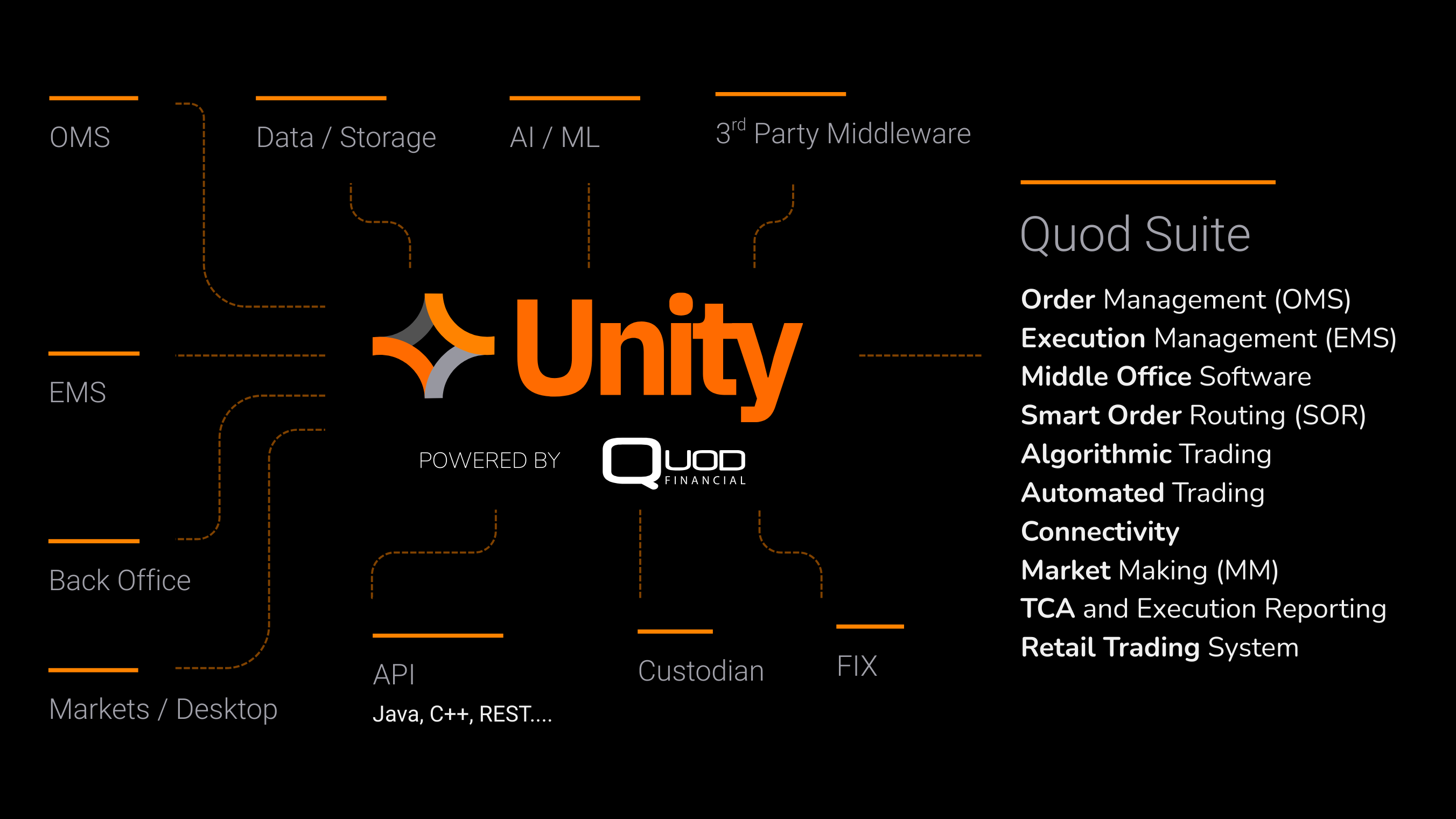Seamless and faster integration through
Plugins
One Connected Flow
No Replacements.
No Disruptions.
Unified Trading Architecture
Modernize Without Disruption.

Real-time order lifecycle visibility

300+ prebuilt vendor connectors

Modular, composable microservices

Interactive dashboards, alerts, and exception management

Rapid deployment — new vendors in days, not months

Vendor-neutral — plug in Quod Apps or third parties

Your Infrastructure Your Choice
Unity provides a stable, lifecycle-aware integration layer for your entire trading architecture. Enhance with Quod’s advanced execution tools or integrate your preferred vendors — Unity enables modernization at your pace, without compromising resilience or control.
Either way, you control the architecture.

Why You Need Unity?
For Normalized, Cross-Asset Integration & Full Order Lifecycle
Feature |
Unity Advantage |
|
System Replacement |
⚡ Only if you want to |
|
Go Live Timeline |
⚡ Operational in 4–8 weeks |
|
Vendor Neutral |
⚡ Yes |
|
AI & Lifecycle Aware |
⚡ Built-in |
|
Cross-Asset, Real-Time Views |
⚡ Dashboards, Alerts, P&L, Risk Monitoring |
Who Relies on Unity?
Modernization for Trading Firms with Global Complexity.
A mid-sized wealth management firm oversees portfolios for hundreds of HNWIs — but behind the polished client interface is a tangle of systems: a bespoke investment portal, a third-party OMS, custodian feeds via FTP, Excel-based reporting, and a CRM that doesn’t talk to any of it. Every month, reconciling trades and preparing reports is a fire drill, and their new AI tool for tax-loss harvesting is feeding on inconsistent data.
A mid-sized wealth management firm oversees portfolios for hundreds of HNWIs — but behind the polished client interface is a tangle of systems: a bespoke investment portal, a third-party OMS, custodian feeds via FTP, Excel-based reporting, and a CRM that doesn’t talk to any of it. Every month, reconciling trades and preparing reports is a fire drill, and their new AI tool for tax-loss harvesting is feeding on inconsistent data.
A global bank invests in a new OMS designed to streamline European trading — it’s fast, compliant, and deeply integrated… within EMEA. But there’s a catch: it doesn’t cover U.S. markets. So every time a North American desk needs to route orders, ops teams step in — manually replicating tickets, reconciling fills, and introducing latency and risk into what should be automated.
Instead of duplicating systems or introducing a second OMS, the bank deploys Unity as a foundational integration layer. It connects the European OMS to U.S. execution venues and brokers, normalizes the order lifecycle across both regions, and feeds everything into the same post-trade and compliance stack. Overnight, a regional platform becomes global — and manual workarounds become automated workflows.
A hedge fund invests in advanced AI models to optimize trade execution — but performance stalls. The problem? Each desk pulls order and execution data from a different source: FlexTrade, Fidessa, Bloomberg, and internal tools. Latency and data mismatches muddy the signals. The AI doesn’t stand a chance.
Deployed as a real-time normalization layer, Unity ingests, aligns, and cleans data across OMS, EMS, and market feeds. It creates a single, standardized view of order lifecycle data — from parent orders to fills and benchmarks. Suddenly, the AI models work as intended. Predictive analytics improve. Automation expands. Clean data wasn’t a luxury — it was the missing foundation.
A multi-asset dealer’s operations team spends each morning chasing trade breaks. Execution data from the front office rarely matches what the back office sees — with errors spotted hours too late to fix. Reporting is delayed. Risk builds up silently.
As a lifecycle-aware integration layer, Unity captures trades, fills, and execution states in real time. It connects front-office systems to middle and back office with full visibility. Exception dashboards light up instantly when something breaks — not tomorrow, but now. The ops team no longer reacts after the fact. They resolve issues before they become problems.
A global broker decides to replace its legacy EMS to support more asset classes and modern execution algos. But with hundreds of live clients, global desks, and tightly coupled post-trade flows, the migration looks like a 12-month, high-risk transformation. Every change threatens downstream reconciliation, compliance, and client SLAs.
Rather than ripping out infrastructure, they deploy Unity as a foundational integration layer, sitting beneath both EMS platforms. Orders are normalized across systems. FIX messaging is mapped in real time. And post-trade reporting continues uninterrupted. The migration is completed in under 60 days — with zero operational downtime. For the first time, switching vendors isn’t a crisis — it’s a controlled upgrade.
